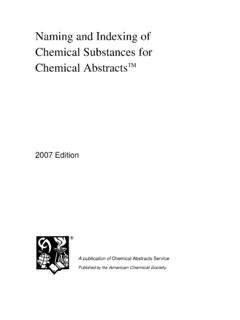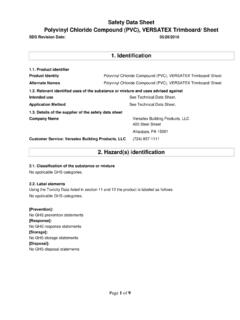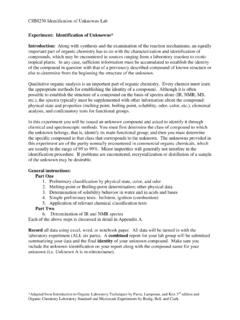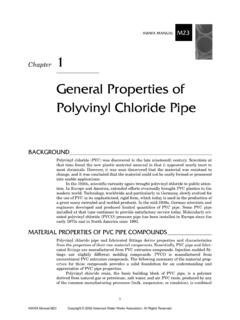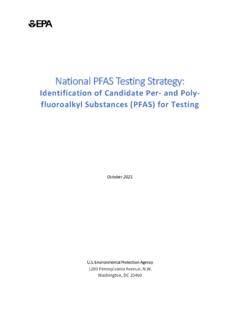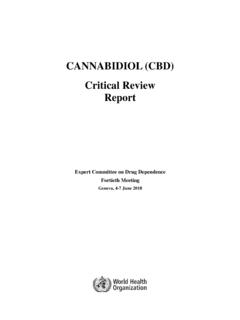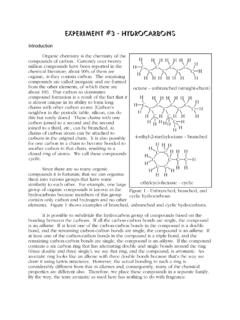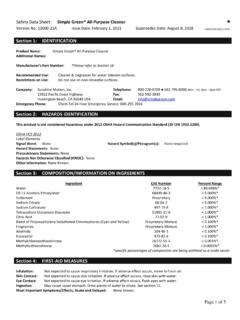Transcription of 6.1 Carbon Black
1 Carbon Process DescriptionCarbon Black is produced by the reaction of a hydrocarbon fuel such as oil or gas with a limitedsupply of combustion air at temperatures of 1320 to 1540 C (2400 to 2800 F). The unburned Carbon iscollected as an extremely fine Black fluffy particle, 10 to 500 nanometers (nm) in diameter. The principaluses of Carbon Black are as a reinforcing agent in rubber compounds (especially tires) and as a blackpigment in printing inks, surface coatings, paper, and plastics. Two major processes are presently used inthe United States to manufacture Carbon Black , the oil furnace process and the thermal process. The oilfurnace process accounts for about 90 percent of production, and the thermal, about 10 percent. Twoothers, the lamp process for production of lamp Black and the cracking of acetylene to produce acetyleneblack, are each used at 1 plant in the U.
2 S. However, these are small-volume specialty Black operationsthat constitute less than 1 percent of total production in this country. The gas furnace process is beingphased out, and the last channel Black plant in the U. S. was closed in Oil Furnace Process -In the oil furnace process (Figure and Table ), an aromatic liquid hydrocarbonfeedstock is heated and injected continuously into the combustion zone of a natural gas-fired furnace,where it is decomposed to form Carbon Black . Primary quench water cools the gases to 500 C (1000 F)to stop the cracking. The exhaust gases entraining the Carbon particles are further cooled to about 230 C(450 F) by passage through heat exchangers and direct water sprays. The Black is then separated fromthe gas stream, usually by a fabric filter.
3 A cyclone for primary collection and particle agglomerationmay precede the filter. A single collection system often serves several manifolded recovered Carbon Black is finished to a marketable product by pulverizing and wet pelletizingto increase bulk density. Water from the wet pelletizer is driven off in a gas-fired rotary dryer. Oil orprocess gas can be used. From 35 to 70 percent of the dryer combustion gas is charged directly to theinterior of the dryer, and the remainder acts as an indirect heat source for the dryer. The dried pellets arethen conveyed to bulk storage. Process yields range from 35 to 65 percent, depending on the feedcomposition and the grade of Black produced. Furnace designs and operating conditions determine theparticle size and the other physical and chemical properties of the Black .
4 Generally, yields are highest forlarge particle blacks and lowest for small particle Thermal Process -The thermal process is a cyclic operation in which natural gas is thermally decomposed (cracked)into Carbon particles, hydrogen, and a mixture of other organics. Two furnaces are used in normaloperation. The first cracks natural gas and makes Carbon Black and hydrogen. The effluent gas from thefirst reactor is cooled by water sprays to about 125 C (250 F), and the Black is collected in a fabric filtered gas (90 percent hydrogen, 6 percent methane, and 4 percent higher hydrocarbons) is used as afuel to heat a second reactor. When the first reactor becomes too cool to crack the natural gas feed, thepositions of the reactors are reversed, and the second reactor is used to crack the gas while the first isheated.
5 Normally, more than enough hydrogen is produced to make the thermal Black processself-sustaining, and the surplus hydrogen is used to fire boilers that supply process steam and (Reformatted 1/95)Organic chemical Process Flow diagram for the oil furnace Carbon Black FACTORS(Reformatted 1/95)5/83 Table STREAM IDENTIFICATION FOR THE OIL FURNACE PROCESS (FIGURE )StreamIdentification1 Oil feed2 Natural gas feed3 Air to reactor4 Quench water5 Reactor effluent6 Gas to oil preheater7 Water to quench tower8 Quench tower effluent9 Bag filter effluent10 Vent gas purge for dryer fuel11 Main process vent gas12 Vent gas to incinerator13 Incinerator stack gas14 Recovered Carbon black15 Carbon Black to micropulverizer16 Pneumatic conveyor system17 Cyclone vent gas recycle18 Cyclone vent gas19 Pneumatic system vent gas20 Carbon Black from bag filter21 Carbon Black from cyclone22 Surge bin vent23 Carbon Black to pelletizer24 Water to pelletizer25 Pelletizer effluent26 Dryer direct heat source vent27 Dryer heat exhaust after bag filter28 Carbon Black from dryer bag filter29 Dryer indirect heat source vent30 Hot gases to
6 Dryer5/83(Reformatted 1/95)Organic chemical Process (cont.).StreamIdentification31 Dried Carbon black32 Screened Carbon black33 Carbon Black recycle34 Storage bin vent gas35 Bagging system vent gas36 Vacuum cleanup system vent gas37 Combined dryer vent gas38 Fugitive emissions39 Oil storage tank vent gasThe collected thermal Black is pulverized and pelletized to a final product in much the samemanner as is furnace Black . Thermal process yields are generally high (35 to 60 percent), but therelatively coarse particles produced, 180 to 470 nm, do not have the strong reinforcing properties requiredfor rubber Emissions And Oil Furnace Process -Emissions from Carbon Black manufacture include particulate matter, Carbon monoxide (CO),organics, nitrogen oxides, sulfur compounds, polycyclic organic matter (POM), and trace principal source of emissions in the oil furnace process is the main process vent.
7 The ventstream consists of the reactor effluent and the quench water vapor vented from the Carbon Black recoverysystem. Gaseous emissions may vary considerably according to the grade of Carbon Black beingproduced. Organic and CO emissions tend to be higher for small particle production, corresponding withthe lower yields obtained. Sulfur compound emissions are a function of the feed sulfur content. , , and show the normal emission ranges to be expected, with typical average combined dryer vent (stream 37 in Figure ) emits Carbon Black from the dryer bag filterand contaminants from the use of the main process vent gas if the gas is used as a supplementary fuel forthe dryer. It also emits contaminants from the combustion of impurities in the natural gas fuel for thedryer.
8 These contaminants include sulfur oxides, nitrogen oxides, and the unburned portion of each of thespecies present in the main process vent gas (see Table ). The oil feedstock storage tanks are asource of organic emissions. Carbon Black emissions also occur from the pneumatic transport systemvent, the plantwide vacuum cleanup system vent, and from cleaning, spills, and leaks (fugitive emissions).Gaseous emissions from the main process vent may be controlled with CO boilers, incinerators,or flares. The pellet dryer combustion furnace, which is, in essence, a thermal incinerator, may also beemployed in a control system. CO boilers, thermal incinerators, or combinations of these devices canachieve essentially complete oxidation of organics and can FACTORS(Reformatted 1/95)5/83 Table (Metric And English Units).
9 EMISSION FACTORS FOR chemical SUBSTANCESFROM OIL FURNACE Carbon Black MANUFACTUREaChemical SubstanceMain Process Vent Gasbkg/Mglb/tonCarbon disulfide3060 Carbonyl sulfide1020 Methane2550(10 - 60)(20 - 120)Nonmethane VOCA cetylene4590(5 - 130)(10 - 260) elementsd< < in terms of weight of emissions per unit weight of Carbon Black produced. VOC = volatileorganic chemical substances are emitted only from the main process vent. Average values are based on 6sampling runs made at a representative plant (Reference 1). Ranges given in parentheses are based onresults of a survey of operating plants (Reference 4).cBelow detection limit of 1 , lead, and mercury, among several compounds in the process flue gas. Combustion efficiencies of percent for hydrogen sulfideand percent for CO have been measured for a flare on a Carbon Black plant.
10 Particulate emissionsmay also be reduced by combustion of some of the Carbon Black particles, but emissions of sulfur dioxideand nitrogen oxides are thereby Thermal Process -Emissions from the furnaces in this process are very low because the offgas is recycled andburned in the next furnace to provide heat for cracking, or sent to a boiler as fuel. The Carbon Black isrecovered in a bag filter between the 2 furnaces. The rest is recycled in the offgas. Some adheres to thesurface of the checkerbrick where it is burned off in each firing (Reformatted 1/95)Organic chemical Process (Metric Units). EMISSION FACTORS FOR Carbon Black MANUFACTUREaEMISSION FACTOR RATING: CProcessParticulatebCarbonMonoxideNitrog enOxidesSulfurOxidesMethaneNonmethaneVOC cHydrogenSulfideOil furnace processMain process , ,f25e50e30e( - 5)(700 - 2,200)(1 - )(0 - 12)(10 - 60)(10 - 159)(5S - 13S) ( - )(108 - 137)( - 28)( - 2)CO boiler and dryer venthBag ( - )( - )( - ) ( - )Pneumatic system venthBag ( - )Oil storage tank cleanup system venthBag ( - )Fugitive waste FACTORS(Reformatted 1/95)5/83 Table (cont.)










